Yo, Primate
- Catalina Restrepo
- 9 nov 2022
- 6 Min. de lectura
Artistas: Omar Arcega, Raúl Cerrillo, Sofía Echeverri, Alejandra España, Rodrigo Imaz, Emilio Rangel, Gabriela Rodríguez, Juan Antonio Sánchez- Rull, Saúl Sánchez BORDER, CDMX
fecha:
El proyecto YO, PRIMATE nace de la propuesta de varios artistas –provenientes de ciudades y contextos distintos- que a partir de la figura del mono reflexionan sobre situaciones y actitudes del ser humano. Los trabajos de esta exposición funcionan como una especie de proyección de rasgos del ser humano hacia diferentes especies de monos, mismos que tienen que ver con una gran diversidad de referentes culturales, científicos, religiosos, históricos y populares.
El simio (1), o mono, siempre se ha relacionado de manera directa con el hombre, al compartir ambos un pasado evolutivo como homínidos. Esta carga simbólica está ligada a connotaciones positivas y negativas. En algunos casos se relaciona con la parte instintiva, impulsiva, primitiva y natural del ser humano, misma que alude a un sentimiento de libertad. Otras veces la representación del mono se asocia a la falta de inteligencia y modales, es decir, la supuesta antítesis del ser humano, quien es lampiño, erguido, moderno, educado y evolucionado.
Como parte de la investigación se presenta un video en el cual se compilan diferentes tipos de clips extraídos de youtube que vinculan el comportamiento de ambas especies, aunque esta vez a partir de la mirada de la cultura popular y los medios de comunicación.
----
1. Simio es un término común, sin equivalente taxonómico, con el que se denomina a un amplio conjunto de primates Simiformes. Simio y mono son originalmente sinónimos en español, aunque existe una tendencia a separar sus significados por influencia del inglés, donde el término “ape” (simio) suele usarse para referirse a lo que en español sería “homínido”, es decir, humanos, chimpancés, orangutanes y gorilas; los “grandes simios”
Juan Antonio Sánchez-Rull, presentó una serie fotográfica llamada Casa Darwin en la que retrata monos del Zoológico de Chapultepec en la Ciudad de México y los espacios “naturales” construidos artificialmente nos recuerdan asilos, cárceles, hospitales... espacios construidos artificialmente creados para nosotros los humanos también
Emilio Rangel, mostró dos esculturas; uno de su serie Victoria's Angels, 2007 y el otro de Bodybuilder, Gay, Metrosexual, Chimpanzee, 2007. El primero es una asombrosa chimpancé hembra de tamaño natural en lencería con expresión de modelo, y el otro es una especie de Hulk Hogan. chimpancé de aspecto en tanga. Emilio utiliza la figura del mono para señalar cómo los humanos (erectos y sin pelo) se esfuerzan tanto en negar su pasado evolutivo, sin embargo, siguen comportándose como chimpancés mientras siguen imitando las tonterías que hacen los demás.
Saúl Sánchez aborda un tema completamente diferente con su proyecto Estás aquí, 2009, en el que presenta pinturas hiperrealistas de monos, aprendiendo signos de ubicación, tales como: alrededor, encima, debajo, etc. Relaciona estas direcciones -que son las primeras cosas que aprendemos como humanos- con qué, nos define en la vida adulta en términos de dónde estamos y dónde queremos estar. Con su obra, Saúl, habla de límites, fronteras mentales y geográficas que a veces nos alejan de lo que queremos.
Raúl Cerrilo En su obra el uso de la figura del mono es muy común y está ligado a una imagen que simboliza el inconsciente, la parte instintiva del ser humano que se esconde en el cerebro entre modales y códigos de vestimenta. Cerrillo destaca la parte animal que se apodera de nuestros pensamientos y nos hace hacer cosas que podrían considerarse locas, sin razón, excéntricas o maníacas. En ese sentido, su obra es autorreferencial, es precisamente lo que le sucede cuando está dentro del trance en el que se encuentra al producir su pintura. En trabajos recientes también ha realizado una serie de fotomontajes donde la figura del mono irrumpe con la misma connotación crítica ya la vez liberadora.
Omar Arcega compara la evolución de las armas con la evolución de los homínidos superponiendo dibujos de armaduras con las cabezas de los animales. Utiliza el mono para señalar la naturaleza humana pero de forma negativa o crítica.
Sofía Echeverría, habla de una crisis socioambiental al presentar una hermosa serie de dibujos en los que se pueden ver diferentes tipos de monos, todos en peligro de extinción, donde aparecen dormidos pero es inevitable pensar que están muertos.
Alejandra España
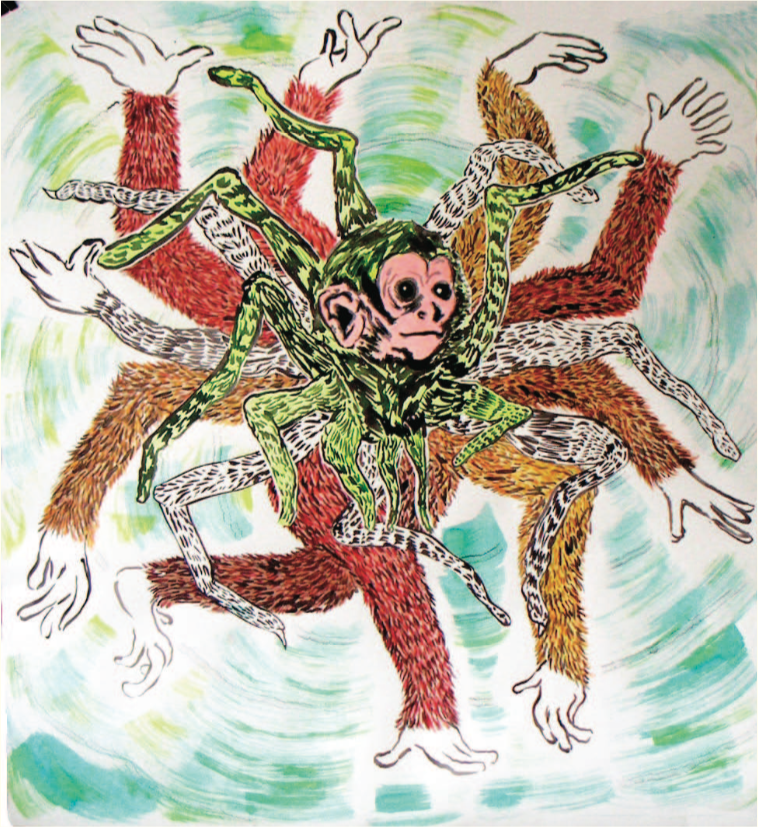
Rodrigo Imaz
Gabriela Rodríguez exhibió una pieza en la que presentó diferentes objetos y cerámicas que parecían huesos y vestigios arqueológicos, abordando el interés de la ciencia por encontrar evidencias de nuestra existencia y nuestro pasado. Finalmente Saúl Sánchez aborda un tema completamente diferente con su proyecto Estás aquí, 2009, en el que presenta pinturas hiperrealistas de monos, aprendiendo signos de ubicación, como: alrededor, encima, debajo, etc. Relaciona estas direcciones -que son las primeras cosas que aprendemos como humanos- con qué, nos define en la vida adulta en términos de dónde estamos y dónde queremos estar. Con su obra, Saúl, habla de límites, fronteras mentales y geográficas que a veces nos alejan de lo que queremos.

I, PRIMATE Project stems from the point of view of different artists coming from different contexts, whose interests rely on the thoughts around the figure of the monkey and it’s relation with humans. The works in this exhibition, function as a kind of projection of humans to different species of monkeys and deal with a wide range of cultural, scientific, religious, historical and popular references around the subject.
The Ape (1), or monkey, always has been linked directly with humans, sharing both an evolutionary past as hominids. This symbolism is linked to positive and negative connotations. In some cases it relates to the instinctive, impulsive, primitive and wild side of the human being, it alludes to a sense of freedom in a positive way, or sometimes, in a negative way when it points out to the dark side of our nature. Sometimes representation of monkeys is associated with lack of intelligence and manners, suggesting the supposed antithesis of man, who is hairless, erect, modern, educated and evolved.
As a curatorial experiment, this small text was presented along with a video essay in which youtube clips were extracted. These fragments of audiovisual material, show different ways in which humans and apes are related. From funny videos, advertising, scientific experiments, up to NASA rocket launchings, popular culture excerpts, etcetera.
----
1. Ape is a common term, without taxonomic equivalent, which is referred to a wide range of primate Simiiformes. Ape and monkey are originally synonyms in Spanish, although there is a tendency to separate their meanings under the influence of English, where the term ape is often used to refer to what in Spanish would be “hominid” or great apes: humans, chimpanzees, orangutans and gorillas.
Juan Antonio Sanchez-Rull, presented a photographic series called Darwin House in which he portraits monkeys form Chapultepec Zoo in Mexico City and the “natural” artificially-builded spaces remind us asylums, jails, hospitals... artificially- builded spaces created for us humans too.
Emilio Rangel, showed two sculptures; one from his series Victoria’s Angels, 2007 and the other one from Bodybuilder, Gay, Metrosexual, Chimpanzee, 2007. The first one is an amazing life size female chimpanzee in lingerie with a model expression, and the other one is a Hulk Hogan kind-of-look chimpanzee in thong. Emilio uses the figure of the monkey in order to point out how humans (erect and hairless) try so hard to deny their evolutionary past, however, they are still behaving like chimpanzees as long as they keep imitating the silly things that others do.
Saúl Sánchez deals with a completely different subject with his project You Are Here, 2009, in which he presented hiperrealistic paintings of monkeys, learning location signs, such as: around, over, under, etc. He relates this directions-which are the first things that we learn as humans- with what, it defines us in adult life in terms of where we are and where we want to be. With his work, Saúl, speaks about limits, mental and geographical borderlines that sometimes keep us apart from what we want.
Raúl Cerrilo In his work using the figure of the monkey is very common and is linked to an image that symbolizes the unconscious, the instinctive part of human who hides in the brain between manners and dress codes. Cerrillo highlights the animal part that grips our thoughts and makes us do things that might be considered crazy, unreason, eccentric or manic. In this sense, his work is self-referential, it is precisely what happens to him when he is within the trance he is into when his producing his painting. In recent works, he has also produced a series of photomontages where the figure of monkey bursts with the same critical and at the same time liberating connotation.
Omar Arcega compares the evolution of guns with evolution of the hominids by overlapping drawings of armor with the heads of the animals. He uses the monkey to point out the human nature but in a negative or critical way
Sofía Echeverria, speaks about a social environmental crisis by presenting a beautiful series of drawings in which you can see different types of monkeys, all of them endangered, were they all appear sleeping but is inevitable to think they are dead.
Alejandra España
Rodrigo Imaz
Gabriela Rodriguez exhibited a piece in which she presented different objects and ceramics that looked like bones and archeological traces, addressing the interest of science to find evidences of our existence and our past. Finally Saúl Sánchez deals with a completely different subject with his project You Are Here, 2009, in which he presented hiperrealistic paintings of monkeys, learning location signs, such as: around, over, under, etc. He relates this directions-which are the first things that we learn as humans- with what, it defines us in adult life in terms of where we are and where we want to be. With his work, Saúl, speaks about limits, mental and geographical borderlines that sometimes keep us apart from what we want.















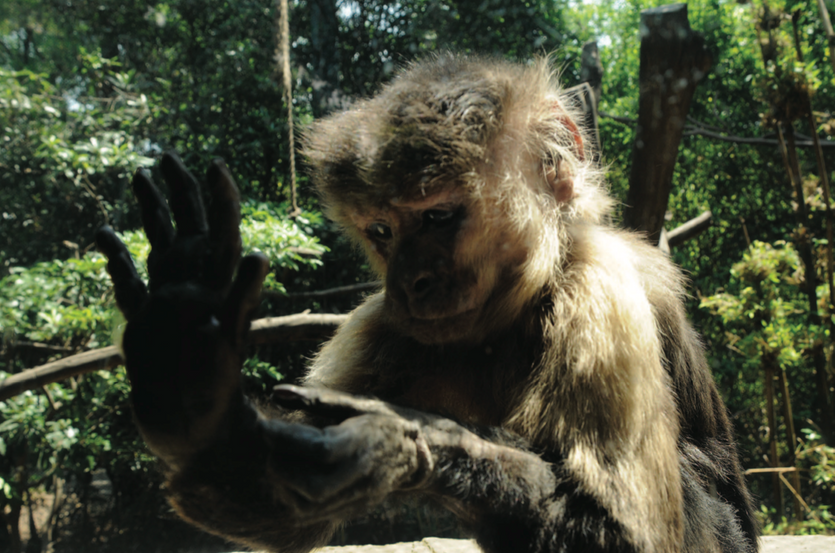























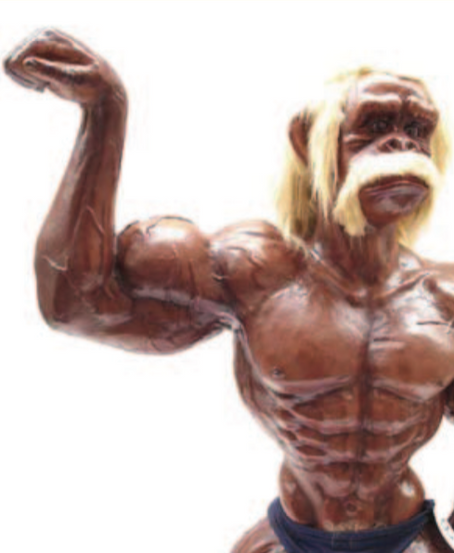





























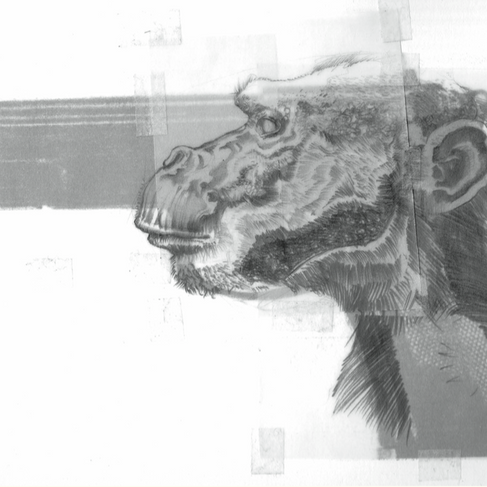











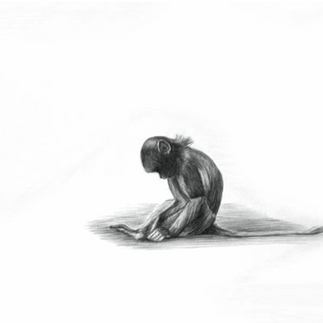











Comentarios